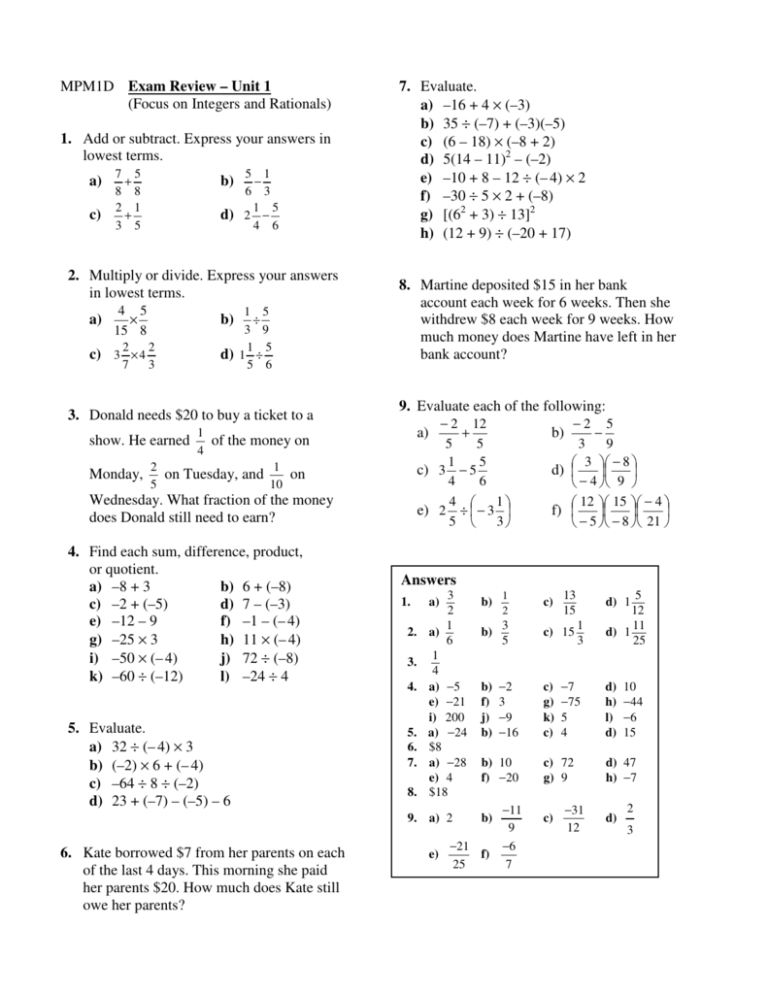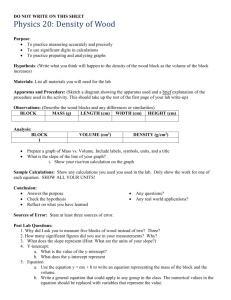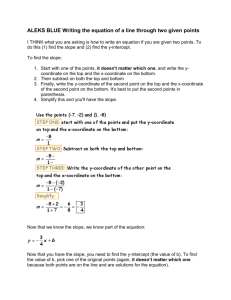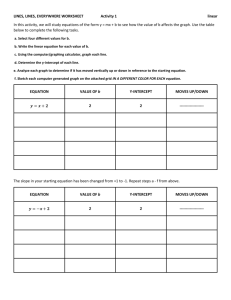MPM1D Exam Review – Unit 1 (Focus on Integers and Rationals) 1
advertisement

MPM1D Exam Review – Unit 1 (Focus on Integers and Rationals) 1. Add or subtract. Express your answers in lowest terms. a) c) 7 5 + 8 8 2 1 + 3 5 b) d) 5 1 − 6 3 1 5 2 − 4 6 2. Multiply or divide. Express your answers in lowest terms. a) 4 5 × 15 8 2 7 c) 3 × 4 b) 2 3 d) 1 5 ÷ 3 9 1 5 1 ÷ 5 6 3. Donald needs $20 to buy a ticket to a show. He earned Monday, 2 5 1 4 7. Evaluate. a) –16 + 4 × (–3) b) 35 ÷ (–7) + (–3)(–5) c) (6 – 18) × (–8 + 2) d) 5(14 – 11)2 – (–2) e) –10 + 8 – 12 ÷ (– 4) × 2 f) –30 ÷ 5 × 2 + (–8) g) [(62 + 3) ÷ 13]2 h) (12 + 9) ÷ (–20 + 17) 8. Martine deposited $15 in her bank account each week for 6 weeks. Then she withdrew $8 each week for 9 weeks. How much money does Martine have left in her bank account? 9. Evaluate each of the following: − 2 12 + 5 5 1 5 c) 3 − 5 4 6 4 1 e) 2 ÷ − 3 5 3 a) of the money on on Tuesday, and 1 10 on Wednesday. What fraction of the money does Donald still need to earn? 4. Find each sum, difference, product, or quotient. a) –8 + 3 b) 6 + (–8) c) –2 + (–5) d) 7 – (–3) e) –12 – 9 f) –1 – (– 4) g) –25 × 3 h) 11 × (– 4) i) –50 × (– 4) j) 72 ÷ (–8) k) –60 ÷ (–12) l) –24 ÷ 4 5. Evaluate. a) 32 ÷ (– 4) × 3 b) (–2) × 6 + (– 4) c) –64 ÷ 8 ÷ (–2) d) 23 + (–7) – (–5) – 6 Answers 1. 2. 3. 4. 5. 6. 7. 8. 3 2 1 a) 6 1 4 a) −5 e) −21 i) 200 a) −24 $8 a) −28 e) 4 $18 a) 9. a) 2 6. Kate borrowed $7 from her parents on each of the last 4 days. This morning she paid her parents $20. How much does Kate still owe her parents? −2 5 − 3 9 3 − 8 d) − 4 9 12 15 − 4 f) − 5 − 8 21 b) 13 15 b) 1 2 c) b) 3 5 c) 15 b) f) j) b) −2 3 −9 −16 c) g) k) c) b) 10 f) −20 b) −21 e) f) 25 −11 9 −6 7 1 3 −7 −75 5 4 c) 72 g) 9 c) 5 12 11 d) 1 25 d) 1 −31 12 d) h) l) d) 10 −44 −6 15 d) 47 h) −7 d) 2 3 MPM1D Exam Review – Unit 2 1. Evaluate. a) 53 c) –34 (Focus on Powers and Algebra) b) 28 d) (–2)4 2 f) 3 10 e) (–1) 7. State the degree of each term. a) –8b4 b) –x4y3 8. Simplify each expression. a) 2b + 7g – 5b – 8g b) 3x + y2 + 5y2– 7x c) 6q + u + 4u + q + u + 4u – u d) 10 – m2 – 7 – m2 + 4m2 e) –3v + 2v + 6 – 3v – 9 – v f) 7 + h + h – 5 + 6h + 2 + 3h 9. Simplify. a) (6k – 4) + (2k + 4) b) (2a + 1) – (4a + 2) c) (b – 6) – (2 – 5b) + (b + 4) d) (g + 12) + (g – 7) – (2 – 3g) e) (x2 + 2x + 1) + (2x2 + 4) f) (2m2 + m + 12) – (3m2 + 4m – 6) 3 2. Evaluate. Use the correct order of operations. a) 34 + 42 b) 72 – 7 2 c) 9 ÷ 3 2 e) (32 + 42) 2 d) 5 × 5 f) (3 + 4)2 3 3. Write as a single power. Then, evaluate. a) 85 × 84 ÷ 87 b) 67 ÷ 65 ÷ 6 3 4 3 4 c) (3 ) ÷ 3 9 d) (5 ) × 52 510 e) 27 × 25 ÷ (22)4 f) [(–6)3]3 ÷ [(–6)2]4 4. Simplify. a) b6 × b3 b) g2 × g8 ÷ g7 c) (a5)3 ÷ (a4)2 d) m5n × m2n4 7 4 3 4 e) p q ÷ p q f) 8b3 d × 4bd 2 2 ( 2bd ) 2 5. Identify the coefficient and the variable for each term. a) 7m c) 3 2 mn 7 b) –3x5 d) gh 6. Classify each expression as a monomial, binomial, trinomial, or polynomial. a) a2 – 2a + 1 b) 2 – 3x4 – 5x2 + 4x c) 6m2n5 10. Expand. a) 5(x + 3) b) 4(b + 2) c) w(2w + 1) d) q(q + 4) e) 3c(6 – 4c) f) –p(2p – 1) g) –5(a2 – 4a – 2) h) 2d(d2 – 3d – 1) 11. Expand and simplify. a) 3(x + 3) + 2(x + 1) b) –4(m + 2) + 3(m – 7) c) –(d – 3) – 5(d + 2) d) 5[b + 2(b + 1)] e) –2[3(a + 3) – 4] f) 4[–2(4 – t) + 3t] Unit 2 Answers 1. a) 125 b) 256 d) 16 e) 1 2. a) 97 b) 42 d) 3. 4. 5. a) d) a) d) a) b) c) d) 6. a) c) 7. a) 8. a) c) e) 9. a) c) e) 10. a) c) e) g) 11. a) c) e) c) c) −81 8 f) 27 c) 9 ( ) ( ) 8 e) 25 f ) 49 25 82; 64 b) 61; 6 c) 33; 27 54; 625 e) 24; 16 f ) (−6)1; −6 9 b b) g3 c) a7 7 5 4 m n e) p f ) 4b2d coefficient: 7; variable m coefficient: −3; variable x5 3 coefficient: ; variable m2n 7 coefficient: 1; variable gh trinomial b) polynomial monomial 4 b) 7 −3b − g b) −4x + 6y2 7q + 9u d) 3 + 2m2 −5v − 3 f ) 4 + 11h 8k b) −2a − 1 7b − 4 d) 5g + 3 3x2 + 2x + 5 f ) −m2 − 3m + 18 5x + 15 b) 4b + 8 2w2 + w d) q2 + 4 q 2 f ) −2p2 + p 18c − 12c 2 −5a + 20a + 10 h) 2d3 − 6d2 − 2d 5x + 11 b) −m − 29 −6d − 7 d) 15b + 10 −6a − 10 f ) −32 + 20t d) 7 – 6s = 19 4. Solve. a) 2m + 5m – 3 = 4 b) 4b – 6 + b – 9 = 0 c) 3x – x + 4 = 0 d) 2k + 3 = 4k – 5 5. Solve. a) 2 + (4h – 1) = 11 + 2h b) 8 – (2g + 3) = 3g – 5 c) 2(d + 6) = 9(d – 1) d) 5(3r – 7) + r = 3(r – 3) 6. Solve. a) 4s + 3 – s = –6 b) p – 3 + 2p – 9 = 0 c) 5 – (c + 3) = 4 + c d) 3(4d – 7) – 6 = 2(d + 2) – 1 7. The perimeter of an isosceles triangle is 21 cm. The length of each equal side is triple the length of the base. Find the side lengths of the triangle. 8. Solve. a) Unit 3 Review (Equations and Problem Solving) 1. Solve. a) 5y = 35 x c) =7 4 b) c) b) b – 8 = –12 d) d) h + 5 = 13 2. Solve. a) 8m + 9 = –15 b) 2p + 7 = 3 c) 5 – 4k = –7 d) 4 + 3c = –12 3. Solve, then check with a formal verification. a) –2a = –22 b) 3 – q = –5 1 g = –9 2 9. t −6 2 =4 1 (c + 2) = 1 3 4a + 1 = −5 3 2 3 (s – 4) = 4 Solve. a) b) c) d) d +4 2 k −1 3d = = 4 k +3 2 2 4 (q – 3) = 3 3c − 1 5 = 1 4 4c + 1 9 (q + 7) 10. Rearrange each formula to isolate the variable indicated. a) A = lw for l b) P = 2a + 2b for b c) y = mx for x d) l = w + 4 for w e) P = 2a + b for b x −3=8 d) A − 7 = 14 2 e) x + x + 1 = 49 f ) d + 8 = 25 12. Blackie: 34 kg; Jessie: 38 kg 13. 40 c) Unit 4, 5 Review The Straight Line 1. 11. Write an equation for each phrase. a) 4 less than triple a number is 23 b) the sum of double a number and 6 is 16 c) half a number, less 3, is 8 d) the area decreased by 7 is 14 e) the sum of two consecutive integers is 49 f) the distance increased by 8 is 25 12. Blackie’s mass is 4 kg less than Jessie’s mass. Together, Blackie and Jessie have a mass of 72 kg. What is each dog’s mass? 13. Chantal works at a music store. She earns $8 per hour plus $0.05 for each CD she sells. Tonight she is working a 5-h shift. How many CDs must Chantal sell to earn $42? Unit 3 ANSWERS 1. a) 7 b) −4 c) 28 2. a) −3 c) 3 b) −2 a) 11 b) 8 a) 1 b) 3 a) 5 b) 2 a) −3 b) 4 3 cm, 9 cm, 9 cm a) 14 b) 1 a) 8 b) 5 10. a) l = A w P − 2a b) b = 2 y c) x = m d) w = l − 4 e) b = P − 2a 11. a) 3x − 4 = 23 3. 4. 5. 6. 7. 8. 9. c) c) c) c) −18 −2 3 −1 c) −4 c) 9 d) 8 d) −16 3 d) −2 d) 4 d) 2 d) 3 d) 10 d) 2 b) 2x + 6 = 16 x y 0 0 1 0.5 2 1.0 3 1.5 4 2.0 5 2.5 a) What is the constant of variation for this relationship? b) Write an equation relating y and x. 2. Classify each relation as a direct variation, a partial variation, or neither. Explain. a) d = 45t b) y = 2x2 + 3 c) y = 2x + 3 d) d = 45t + 12 3. Evan earns $7/h babysitting. The amount he earns, in dollars, varies directly with the time, in hours, he babysits. a) Assign variables. Make a table of values showing Evan’s earnings for 0 h, 1 h, 2 h, 3 h, and 4 h. b) Describe the graph. c) Identify the constant of variation. What does this represent? d) Write an equation in the form y = kx. 4. The relationship between the variables in the table is linear. x y 6 61 12 85 14 93 a) Identify the initial value of y and the constant of variation. b) Write an equation in the form y = mx + b. c) Is this partial or direct variation? 5. The owner of a small business is having brochures printed. The design cost is $1500. Printing costs $0.08 per brochure. The relationship between cost and the number of brochures is a partial variation. a) Identify the fixed cost and the variable cost. b) Write an equation for this relationship. c) What is the total cost for 800 brochures? 10. Tom and Ana ran a race. The graph shows the distance (in metres) each person ran in 10 s. 6. Find the slope of each line segment. a) b) Who ran faster? How much faster? 11. Find the slope and y-intercept of the following line: 7. One endpoint of line segment AB is A(3, 4). The slope of this line segment is 8. 9. 2 . Find possible coordinates for B. 3 It took 8 min to fill a 52-L bucket. a) What is the rate of change of the volume of water? b) Graph the volume of water in the bucket over time. Use first differences. Is each relation linear or non-linear? a) b) x y x y 0 –1 0 0 1 2 1 –2 2 5 2 –4 3 8 3 –6 4 11 4 –8 5 14 5 –10 12. Identify the slope and y-intercept of each line. a) y = 4x – 5 b) y = − 1 x + 2 6 13. Write the equation of a line with each slope and y-intercept. Then, graph each line. a) m = –1, b = 0 b) m = 2 , b = 5 3 14. Express each equation in the form y = mx + b. a) 6x – y = 4 b) x + 4y = 28 15. Identify the slope and y-intercept of each equation. a) 8x + y = 4 b) –3x + 2y = 8 ANSWERS 1 1 1. a) b) y = x 2 2 2. a) b) c) d) 3. a) Time, t Earnings, E 0 0 1 7 2 14 3 21 4 28 b) linear, slope of 7, y int of 0 c) 7; the amount Evan earns each hour he babysits. d) y = 7x 16. Identify the x- and y-intercepts of each line. Then, graph the line a) 4x – 2y = 8 b) 5x + 3y – 15 = 0 17. Which lines are parallel? 2x – 3y + 12 = 0 3y = 2x + 6 3x – 2y = 0 3x + 2y = –4 18. Which lines in question 17 are perpendicular? 19. What is the slope of a line that is perpendicular to 3 – x + 4y = 0? 20. Find the equation of a line with a slope of –3, passing through (2, –5). 21. Find the equation of a line parallel to 2x + 5y = 1, with the same y-intercept as x – 4y = 8. direct variation neither partial variation partial variation. 4. a) 37; 4 b) y = 4x + 37 c) Partial a) fixed cost: $1500 variable cost: $0.08 times the number of brochures b) C = 0.08n + 1500 c) $1564 2 6. a) − b) 5 5 7. Answers may vary. Possible answer: B(6, 6) 8. a) 6.5 L/min b) 5. 22. Find the equation for a line passing through (3, –4) and (2, 5). a) linear b) linear 10. Tom; 1 m/s 11. slope: −2; y-intercept: 6 9. 23. Ingrid is walking in front of a motion sensor. After 1 s, she is 3.9 m from the sensor. After 3 s, she is 1.7 m from the sensor. a) Find the slope for this relationship. b) Write an equation of the form d = mt + b that describes Ingrid’s motion. c) After how many seconds will Ingrid’s distance from the motion sensor be 0? 24. Solve the following linear system: x + y = 6 and y – 2x = 0. slope: 4; y-intercept: −5 b) slope: − 1 ; y-intercept: 2 6 13. a) y = −x 12. a) 22. 23. 24. y = −9x + 23 a) −1.1 b) d = −1.1t + 5 c) About 4.5 s (2, 4) Unit 6 Review Measurement For all questions, round your answer to the nearest tenth of a unit when necessary. b) y = 2 x + 5 3 1. Find the length of each indicated side. a) b) y = 6x − 4 b) y = − x + 7 4 15. a) slope: −8; y-intercept: 4 b) slope: 3 ; y-intercept: 4 2 16. a) x-intercept: 2; y-intercept: −4 14. a) 2. Find the area of this triangle. 3. Find the perimeter and area of each figure. a) b) x-intercept: 3; y-intercept: 5 b) 17. 2x − 3y + 12 = 0 and 3y = 2x + 6 18. 2x − 3y + 12 = 0 and 3x + 2y = −4; 3y = 2x + 6 and 3x + 2y = −4 19. −4 20. y = −3x + 1 21. y = − 2 x − 2 5 4. A pool is 5 m wide by 7 m long. It is surrounded by a deck 2 m wide. What is the area of the deck? 5. Find the surface area and volume of each object. a) b) 6. Find the side length of each cube. a) a cube with volume 3375 cm3 b) a cube with surface area 864 cm2 b) 11. Find the volume of each sphere. a) 7. Calculate the surface area of each cone. a) b) b) 8. Find the volume of each cone. a) b) 12. Which has greater volume? A a hemisphere with radius 12 cm B a sphere with radius 8 cm Answers 9. Find the volume of the largest cone that fits inside a cube with edges 15 cm long. 10. Find the surface area of each sphere. a) 1. a) 5.1 cm b) 3.0 cm 2. 7.1 cm2 3. a) Perimeter: 67.3 cm; Area: 160 cm2 b) Perimeter: 21.4 m; Area: 25.4 m2 4. 64 m2 5. a) Surface area: 360 cm2; Volume: 400 cm3 b) Surface area: 220.5 cm2; Volume: 162 cm3 6. a) 15 cm b) 12 cm 7. a) 178.1 cm2 b) 43.4 cm2 8. a) 66 cm3 b) 2513.3 cm3 3 9. 883.6 cm 10. a) 530.9 cm2 b) 326.9 cm2 3 11. a) 4.2 cm b) 33.5 cm3








